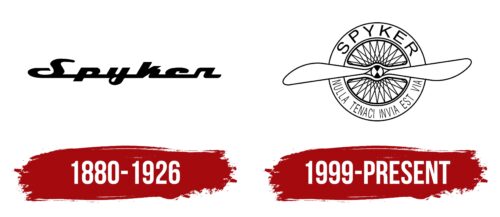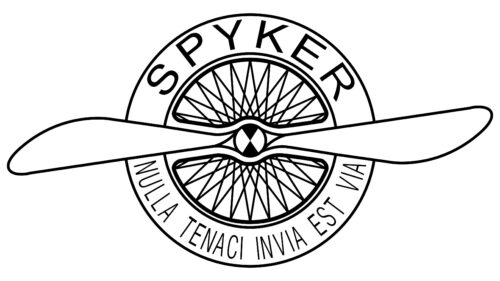The Spyker logo embodies the finest qualities of premium sports cars: a drive for constant motion and innovative leaps. The simple yet meaningful emblem conveys high speed, stability, and reliability in any circumstance.
Spyker: Brand overview
| Founded: | 1999 |
| Founder: | Maarten de Bruijn, Victor Muller |
| Headquarters: | Zeewolde, Netherlands |
| Website: | spykercars.com |
In the late 19th century, the Netherlands saw the birth of the original Spyker company, initially crafting carriages. With time, their expertise evolved, leading them into automobile and aircraft production. Fast forward to 1999, when Victor Muller and Maarten de Bruijn breathed new life into the dormant Spyker name, envisioning a fresh direction centered around premium sports vehicles.
By 2000, the Spyker C8 made its debut, signaling the brand’s entry into the modern sports car era. The design aesthetics of early Spyker racing marvels deeply influenced this vehicle. The brand introduced the opulent C8 Spyder convertible five years later, followed by its automatic transmission counterpart, the Spyder T.
In 2006, showcasing their expansionary vision, Spyker ventured into Formula 1 racing by acquiring the Midland F1 Racing outfit, rechristening it Spyker F1. A year later, enthusiasts were treated to the unveiling of the Spyker C12 La Turbie coupe, a remarkable machine powered by a V12 engine.
2010 witnessed a bold venture as Spyker took over Saab Automobile from General Motors. Regrettably, this endeavor was fraught with challenges, culminating in Saab’s bankruptcy declaration in 2011, marking the end of Spyker’s brand management.
To reclaim lost glory, Spyker initiated production on the B6 Venator concept car in 2013. The intent was to rejuvenate the brand. Still, financial obstacles thwarted those plans. Nonetheless, in 2018, Spyker’s undying spirit was evident at the Geneva Motor Show, where they showcased the C8 Preliator. This launch was a testament to Spyker’s unwavering commitment to crafting groundbreaking sports vehicles.
Meaning and History
What is Spyker?
Spyker Cars, the Dutch sports car brand, has been making waves in the auto industry since its establishment in 1999. Co-founded by Maarten de Bruijn and Victor Muller, the name Spyker has become a byword for meticulous engineering, distinctive aesthetics, and potent performance. As a branch of Spyker N.V. (previously known as Spyker Cars N.V. and Swedish Automobile N.V.), the firm is celebrated for producing an array of high-performance vehicles designed to fulfill the desires of car enthusiasts globally.
Headquartered in Zeewolde, Netherlands, Spyker Cars is recognized for its creations that represent the pinnacle of Dutch craftsmanship and design. Each vehicle embodies an exquisite blend of style, performance, and luxury, reflecting the apex of Dutch engineering standards.
1880 – 1926
The Spyker logo is minimalist, featuring a single inscription—the name of the Dutch sports car manufacturer. This name is written in a handwritten style, mimicking cursive script that resembles a necklace where each letter is carefully strung along a thread of thought, occupying a precise position.
The glyphs are equidistant from each other, introducing order, rigor, and well-thought-out harmony into the emblem. This approach perfectly fits the company’s concept, which is focused on meticulous design and the excellent aesthetics of its cars.
The logo font is square, italic, ultra-bold, and calligraphic. It embodies the idea of the impeccable reliability of sports equipment, which must inherently meet high-quality standards. In this case, the cohesive inscription arranged in a line reflects the precise fit of every detail, allowing the car to speed forward, outrun the wind, and showcase excellent technical performance.
All the glyphs seem to be pressed down by gravity, conveying the real feeling of being pushed into a car seat while driving a high-performance sports car. The first letter, the capital “S,” stands out prominently. It resembles a curved road stretching smoothly into the distance, symbolizing the sharp turns on racing tracks where the brand’s cars have successfully competed.
1999 – today
After a significant update, the Spyker emblem received a completely different look – more thematic and professional. The only element retained from the previous version is the color. The classic combination of black and white adds discipline, an element of strictness, emphasizes a businesslike atmosphere, and brings sophistication. In all other aspects, the logo format has changed dramatically.
- The core of the emblem became a circle similar to a roundel because it has several distinctive features: an accentuated center (in the form of a miniature ball made up of two black and two white triangles) and several wide rings separated by thin lines. Due to the intersecting spokes, the circle also resembles the wheel of a vintage car.
- The new logo includes several inscriptions. Naturally, one of them is the company name, occupying the upper part of the outermost strip. At the bottom is a Latin phrase – “Nulla Tenaci Invia Est Via.” This philosophical saying translates to “For the tenacious, no road is impassable.” It is used to uplift the spirits of the brand’s fans, as it was revived after a long period of neglect.
All inscriptions are in thin uppercase font. The motto is written in narrow letters to fit the long phrase into a small space. The top word is larger and wider to visually balance both lines—the short and the long.
A propeller crosses the circle, overlaying and extending beyond the edges on both sides, visually enlarging the emblem. This symbolizes takeoff, which is very important for the revived brand, whose sports cars are still cherished by those who enjoy driving fast in a luxurious car.






